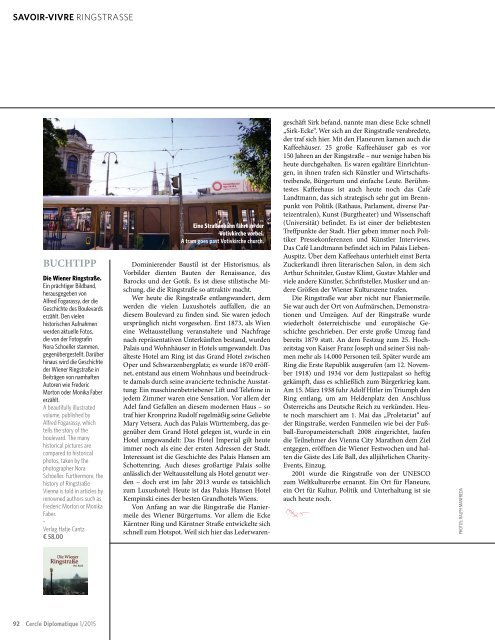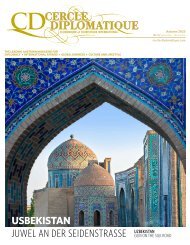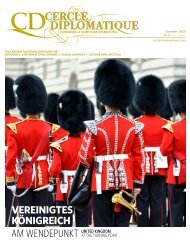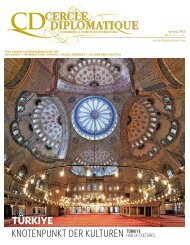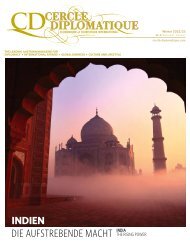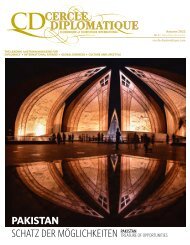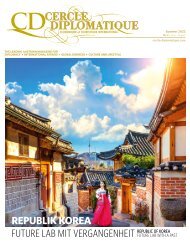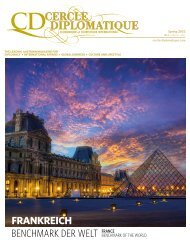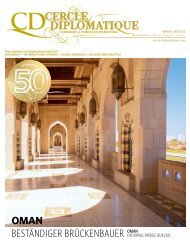IRAK DIE WIEGE DER ZIVILISATION
Create successful ePaper yourself
Turn your PDF publications into a flip-book with our unique Google optimized e-Paper software.
SAVOIR-VIVRE RINGSTRASSE<br />
BUCHTIPP<br />
Die Wiener Ringstraße.<br />
Ein prächtiger Bildband,<br />
herausgegeben von<br />
Alfred Fogarassy, der die<br />
Geschichte des Boulevards<br />
erzählt. Den vielen<br />
historischen Aufnahmen<br />
werden aktuelle Fotos,<br />
die von der Fotografin<br />
Nora Schoeller stammen,<br />
gegenübergestellt. Darüber<br />
hinaus wird die Geschichte<br />
der Wiener Ringstraße in<br />
Beiträgen von namhaften<br />
Autoren wie Frederic<br />
Morton oder Monika Faber<br />
erzählt.<br />
A beautifully illustrated<br />
volume, published by<br />
Alfred Fogarassy, which<br />
tells the story of the<br />
boulevard. The many<br />
historical pictures are<br />
compared to historical<br />
photos, taken by the<br />
photographer Nora<br />
Schoeller. Furthermore, the<br />
history of Ringstraße<br />
Vienna is told in articles by<br />
renowned authors such as<br />
Frederic Morton or Monika<br />
Faber.<br />
–<br />
Verlag Hatje Cantz<br />
€ 58,00<br />
Eine Straßenbahn fährt an der<br />
Votivkirche vorbei.<br />
A tram goes past Votivkirche church.<br />
Dominierender Baustil ist der Historismus, als<br />
Vorbilder dienten Bauten der Renaissance, des<br />
Barocks und der Gotik. Es ist diese stilistische Mischung,<br />
die die Ringstraße so attraktiv macht.<br />
Wer heute die Ringstraße entlangwandert, dem<br />
werden die vielen Luxushotels auffallen, die an<br />
diesem Boulevard zu finden sind. Sie waren jedoch<br />
ursprünglich nicht vorgesehen. Erst 1873, als Wien<br />
eine Weltausstellung veranstaltete und Nachfrage<br />
nach repräsentativen Unterkünften bestand, wurden<br />
Palais und Wohnhäuser in Hotels umgewandelt. Das<br />
älteste Hotel am Ring ist das Grand Hotel zwischen<br />
Oper und Schwarzenbergplatz; es wurde 1870 eröffnet,<br />
entstand aus einem Wohnhaus und beeindruckte<br />
damals durch seine avancierte technische Ausstattung:<br />
Ein maschinenbetriebener Lift und Telefone in<br />
jedem Zimmer waren eine Sensation. Vor allem der<br />
Adel fand Gefallen an diesem modernen Haus – so<br />
traf hier Kronprinz Rudolf regelmäßig seine Geliebte<br />
Mary Vetsera. Auch das Palais Württemberg, das gegenüber<br />
dem Grand Hotel gelegen ist, wurde in ein<br />
Hotel umgewandelt: Das Hotel Imperial gilt heute<br />
immer noch als eine der ersten Adressen der Stadt.<br />
Interessant ist die Geschichte des Palais Hansen am<br />
Schottenring. Auch dieses großartige Palais sollte<br />
anlässlich der Weltausstellung als Hotel genutzt werden<br />
– doch erst im Jahr 2013 wurde es tatsächlich<br />
zum Luxushotel: Heute ist das Palais Hansen Hotel<br />
Kempinski eines der besten Grandhotels Wiens.<br />
Von Anfang an war die Ringstraße die Flaniermeile<br />
des Wiener Bürgertums. Vor allem die Ecke<br />
Kärntner Ring und Kärntner Straße entwickelte sich<br />
schnell zum Hotspot. Weil sich hier das Lederwarengeschäft<br />
Sirk befand, nannte man diese Ecke schnell<br />
„Sirk-Ecke“. Wer sich an der Ringstraße verabredete,<br />
der traf sich hier. Mit den Flaneuren kamen auch die<br />
Kaffeehäuser. 25 große Kaffeehäuser gab es vor<br />
150 Jahren an der Ringstraße – nur wenige haben bis<br />
heute durchgehalten. Es waren egalitäre Einrichtungen,<br />
in ihnen trafen sich Künstler und Wirtschaftstreibende,<br />
Bürgertum und einfache Leute. Berühmtestes<br />
Kaffeehaus ist auch heute noch das Café<br />
Landtmann, das sich strategisch sehr gut im Brennpunkt<br />
von Politik (Rathaus, Parlament, diverse Parteizentralen),<br />
Kunst (Burgtheater) und Wissenschaft<br />
(Universität) befindet. Es ist einer der beliebtesten<br />
Treffpunkte der Stadt. Hier geben immer noch Politiker<br />
Pressekonferenzen und Künstler Interviews.<br />
Das Café Landtmann befindet sich im Palais Lieben-<br />
Auspitz. Über dem Kaffeehaus unterhielt einst Berta<br />
Zuckerkandl ihren literarischen Salon, in dem sich<br />
Arthur Schnitzler, Gustav Klimt, Gustav Mahler und<br />
viele andere Künstler, Schriftsteller, Musiker und andere<br />
Größen der Wiener Kulturszene trafen.<br />
Die Ringstraße war aber nicht nur Flaniermeile.<br />
Sie war auch der Ort von Aufmärschen, Demonstrationen<br />
und Umzügen. Auf der Ringstraße wurde<br />
wiederholt österreichische und europäische Geschichte<br />
geschrieben. Der erste große Umzug fand<br />
bereits 1879 statt. An dem Festzug zum 25. Hochzeitstag<br />
von Kaiser Franz Joseph und seiner Sisi nahmen<br />
mehr als 14.000 Personen teil. Später wurde am<br />
Ring die Erste Republik ausgerufen (am 12. November<br />
1918) und 1934 vor dem Justizpalast so heftig<br />
gekämpft, dass es schließlich zum Bürgerkrieg kam.<br />
Am 15. März 1938 fuhr Adolf Hitler im Triumph den<br />
Ring entlang, um am Heldenplatz den Anschluss<br />
Österreichs ans Deutsche Reich zu verkünden. Heute<br />
noch marschiert am 1. Mai das „Proletariat“ auf<br />
der Ringstraße, werden Fanmeilen wie bei der Fußball-Europameisterschaft<br />
2008 eingerichtet, laufen<br />
die Teilnehmer des Vienna City Marathon dem Ziel<br />
entgegen, eröffnen die Wiener Festwochen und halten<br />
die Gäste des Life Ball, des alljährlichen Charity-<br />
Events, Einzug.<br />
2001 wurde die Ringstraße von der UNESCO<br />
zum Weltkulturerbe ernannt. Ein Ort für Flaneure,<br />
ein Ort für Kultur, Politik und Unterhaltung ist sie<br />
auch heute noch.<br />
PHOTOS: RALPH MANFREDA<br />
The history of Vienna’s Ringstraße began on 25<br />
December 1857. The official Wiener Zeitung<br />
newspaper printed an imperial decree, in<br />
which emperor Franz Joseph gave the order to pull<br />
down the fortifications around the city centre, and<br />
build a magnificent boulevard with representative<br />
buildings in their place. There were several reasons<br />
for this. First of all, city walls were no longer sensible<br />
from a military strategy point of view, and the rapidly<br />
growing suburbs finally had to be better connected<br />
to the imperial-aristocratic centre of power – but<br />
above all, due to the sale of the land, money would<br />
flow into the public coffers. So began the largest<br />
town planning project in the history of the city of<br />
Vienna.<br />
An international competition was tendered, 85<br />
offices submitted suggestions, from which a committee<br />
compiled a “basic plan”: a five kilometre long<br />
and almost 60 metre wide double row street, which<br />
almost formed a circle around Vienna city centre. A<br />
mixed usage was intended: not only public buildings<br />
should line the boulevard, but also palaces, private<br />
rented houses and cultural institutions, as well as<br />
parks and squares. The public buildings should be<br />
partially funded by selling land to private persons.<br />
To give these investors an incentive to purchase land,<br />
they were very generously granted 30 years of tax exemption<br />
on the condition that they complete their<br />
building project within five years.<br />
It actually only took seven years until this monster<br />
building project was sufficiently finished. On 1<br />
May 1865, in front of the castle gate, the not yet completely<br />
finished Ringstraße was officially opened by<br />
Emperor Franz Joseph and his wife Elisabeth. It was<br />
a town planning master stroke. Today, for many,<br />
Ringstraße is the most beautiful boulevard in the<br />
world. However, it took almost 50 years until Ringstraße<br />
was actually completed.<br />
What makes this boulevard so extraordinary and<br />
unique was best described by the English author Edmund<br />
de Waal, in his wonderful, melancholic, immensely<br />
successful novel “The hare with amber<br />
eyes”. “This new road is not dominated by one single<br />
building; there is no crescendo to a palace or a cathedral,<br />
but instead a continual procession from one<br />
great aspect of civilisation to the next”. The focus of<br />
de Waal‘s story is the Palais Ephrussi, which is located<br />
on the Universitätsring. Its fate and the fate of its<br />
inhabitants could stand for many magnificent buildings<br />
along Ringstraße. It is the history of the Jewish<br />
upper classes, it is the story of these Jewish entrepreneurs<br />
and bankers, the Epsteins, the Todescos, the<br />
Ephrussis, who significantly contributed to the economic<br />
upturn of the founding years who benefited<br />
from this boom, and who as patrons and art collectors<br />
significantly contributed to Vienna developing<br />
into a creative incubator in the following years – that<br />
here and above all in the area of Ringstraße arose<br />
what we call the modern age today. The story of these<br />
Jewish upper classes came to a tragic end. In 1938,<br />
after Austria joined the German Reich, they were<br />
expropriated, expelled or murdered.<br />
With all the magnificence and glory of Ringstraße,<br />
we should not forget the stories of those people<br />
who actually built this street. The many thousands of<br />
construction workers and brick layers, who worked<br />
for poor wages on this mega building site under inhuman,<br />
slave like conditions and did piece work, primarily<br />
came from Bohemia and Moravia. That’s why<br />
people called them the “Bohemian bricklayers”. Without<br />
the exploitation of these workers, the Ringstraße<br />
project would never have been completed.<br />
But many of the most important architects and<br />
builders came from all parts of the monarchy, and<br />
the rest of Europe. The look of Ringstraße was characterised<br />
by architects such as Theophil Hansen,<br />
who designed the parliament, the stock exchange,<br />
the academy of fine arts, the musical society, the Palais<br />
Epstein, Ephrussi and Hansen and who came<br />
from Denmark; Gottfried Semper, who came from<br />
Hamburg, whose works included the Neue Burg, the<br />
Vienna Burgtheater, and the Kunsthistorisches and<br />
Natural History Museums Vienna. August Sicard<br />
Die Wiener<br />
Staatsoper wurde<br />
nach dem Zweiten<br />
Weltkrieg neu<br />
aufgebaut.<br />
The Vienna State<br />
Opera was rebuilt<br />
after the 2nd World<br />
War.<br />
92 Cercle Diplomatique 1/2015<br />
Cercle Diplomatique 1/2015<br />
93


